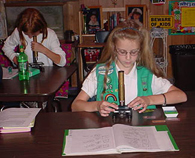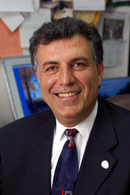One student twists her wedding ring and pushes her reading glasses farther up
her nose as she studies a laminated card filled with information about the
Acrocanthosaurus, an enormous predator that roamed Zilker Park during the
Mesozoic Era. Her gray-haired neighbor shouts out the answer to the teacher's
question, and they exchange a high-five.
The energetic, very vocal pupils are a group of 30 third- through fifth-grade Central Texas teachers gathered at the Austin Nature and Science Center for a day of sharing, brainstorming and intensive training, courtesy of an innovative 12-year-old program in The University of Texas at Austin's College of Education.
Located in the Center for Science and Mathematics Education, the Texas
Regional Collaboratives (TRC) for Excellence in Science Teaching is a network of
Texas school districts, universities, education service centers and businesses
that have joined forces to provide sustained, intensive professional development
and support for Texas science teachers.
Assessment data, as well as input from teachers, testify to the program's efficacy.

Photo: Lisa Anderson, Redwater ISD




